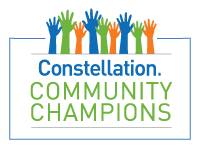Over Here: Life in Laurel During WWII
Exhibit Dates: February - December 2004
The story of Laurel's WWII Spirit. Over Here: Life In Laurel During World War II featured photos, artifacts and objects from the WWII era as they might have been used in a typical Laurel home. The exhibit included a 1940’s era kitchen in the museum’s basement, a parlor area with 1940’s era toys, a living room with a radio airing a Roosevelt Fireside Chat, and a display of WWII era posters, and ration cards, Victory letters and other items donated by Laurel residents who lived through the era in the town. Highlights included military uniforms, and a very special peignoir sewn by local resident Kay Scholl out of dotted Swiss curtains for her war-era honeymoon. The exhibit featured WWII posters loaned by Baltimore's Museum of Industry.
The Laurel Museum followed in the footsteps of thousands of gardeners who dug, hoed, watered and weeded to grow vegetables sixty years. To encourage others to plant a commemorative Victory Garden, Laurel Historical Society member Dave Mann, working with Heirloom Gardens in Alabama, developed a Victory Garden kit In the kit people will find many common and heirloom varieties of seeds, plus some of their history. Most of these would have been varieties available to Victory gardeners Seeds included: West India Burr Gherkin Cucumber,Crisp Mint, Pirat, and Australian Yellowleaf Lettuce, Willowleaf Pole Lima Bean Dragon's Tongue Bush Bean, Danver's Half Long Carrot, Stowell’s Evergreen Corn, Bull’s Blood Beet, Prussian Blue Pea, Martin’s Carrot Pepper
According to Susan Pennington, who presented a program before the Society on Victory Gardens, and who curated the Victory Garden for the Smithsonian’s Within These Walls exhibition, the Victory Garden idea actually started during and at the end of WWI, but took off as WWII started because people were looking for ways to support the war effort. More than 20 million Americans are reported to have planted Victory Gardens and the effort was supported by government agencies, private foundations, businesses, schools and seed companies.
For information on the experiences of African American soldiers after World War II, visit the Prince George's African American Museum and Cultural Center's Exhibit, "Coming Home."
The story of Laurel's WWII Spirit. Over Here: Life In Laurel During World War II featured photos, artifacts and objects from the WWII era as they might have been used in a typical Laurel home. The exhibit included a 1940’s era kitchen in the museum’s basement, a parlor area with 1940’s era toys, a living room with a radio airing a Roosevelt Fireside Chat, and a display of WWII era posters, and ration cards, Victory letters and other items donated by Laurel residents who lived through the era in the town. Highlights included military uniforms, and a very special peignoir sewn by local resident Kay Scholl out of dotted Swiss curtains for her war-era honeymoon. The exhibit featured WWII posters loaned by Baltimore's Museum of Industry.
The Laurel Museum followed in the footsteps of thousands of gardeners who dug, hoed, watered and weeded to grow vegetables sixty years. To encourage others to plant a commemorative Victory Garden, Laurel Historical Society member Dave Mann, working with Heirloom Gardens in Alabama, developed a Victory Garden kit In the kit people will find many common and heirloom varieties of seeds, plus some of their history. Most of these would have been varieties available to Victory gardeners Seeds included: West India Burr Gherkin Cucumber,Crisp Mint, Pirat, and Australian Yellowleaf Lettuce, Willowleaf Pole Lima Bean Dragon's Tongue Bush Bean, Danver's Half Long Carrot, Stowell’s Evergreen Corn, Bull’s Blood Beet, Prussian Blue Pea, Martin’s Carrot Pepper
According to Susan Pennington, who presented a program before the Society on Victory Gardens, and who curated the Victory Garden for the Smithsonian’s Within These Walls exhibition, the Victory Garden idea actually started during and at the end of WWI, but took off as WWII started because people were looking for ways to support the war effort. More than 20 million Americans are reported to have planted Victory Gardens and the effort was supported by government agencies, private foundations, businesses, schools and seed companies.
For information on the experiences of African American soldiers after World War II, visit the Prince George's African American Museum and Cultural Center's Exhibit, "Coming Home."

